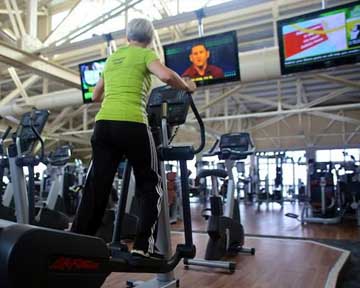What is Fat Pad Syndrome?
There are fat pads throughout the body acting as shock absorbers over bony surfaces. The two fat pads that are most often injured are in the knee and heel, where they are frequently exposed to direct impact. The purpose of the fat pad is to provide cushioning when the underlying bone is pressed against hard surfaces, particularly if done forcefully during intense activity.
When a fat pad receives a direct impact the trauma can cause bruising, swelling and pain. The associated inflammation from such an injury can cause the fat pad to expand against the surrounding tissues, leading to painful impingement from ligaments and tendons. Injury to the fat pad can also cause it to stretch or displace, losing some of its ability to effectively absorb impact. This can lead to further aggravation if repeatedly exposed to direct pressures from overuse.
The fat pad in the knee is located behind the lower half of the patella and extends down and to the sides of the Tibia, behind the Patella Tendon. If inflamed following injury it can be painfully compressed by the Patella Tendon when the knee flexes.
The fat pad in the heel, underneath the calcaneous bone, is possibly the most important as its function is to cushion impact experienced at the heel whilst walking and running. When injured it will feel uncomfortable to walk on with a sensation like a deep bruise. Because of its location Fat Pad Syndrome in the heel is often misdiagnosed as Planta Fasciitis.
What causes Fat Pad Syndrome?
Fat Pad Syndrome is most typically caused by a single traumatic event, usually in the form of a direct blow or fall on to the fat pad. However, it can also result from over use when the fat pad is exposed to prolonged, repetitive lesser impacts.
The risk goes up if there is insufficient periods of rest between activity and biomechanical abnormalities causing excessive or irregular pressure to the fat pad. Old age can also weaken the ligaments around the fat pad, allowing easier displacement, and an increase risk of falls could lead to an impact likely to cause inflammation.
These forces can occur in most normal activates of daily living but are more often experienced when playing sports. Any intense activity involving running, jumping, sudden stops and twisting, especially on uneven surfaces will put you at increased risk of injury. Additional risk factors could include biomechanical abnormalities such as flat feet, poor posture or poor sporting technique. Even inappropriate footwear during exercise can contribute to increased risk.
 Above: A therapist treating a patient for foot pad syndrome
Above: A therapist treating a patient for foot pad syndromeWhat are Symptoms of Fat Pad Syndrome?
The symptoms that characterise Fat Pad Syndrome may include:
- Pain in the centre of the heel that feels like a dull, deep tissue ache.
- Pain worsens if heel is pressed firmly, or when standing and walking.
- Pain is worse if barefoot (i.e. No supporting cushioning) on a hard surface.
- Pain is typically experienced on one side (i.e. within one heel, not both).
Although similar in presentation, the pain from fat pad syndrome is felt in the middle of the heel, rather than at the front of the heel during Planta Fasciitis.
Diagnosis of Fat Pad Syndrome?
Diagnosis of fat pad syndrome can be confirmed by a physiotherapist or a doctor after a thorough examination of your foot and heel.
For more information on how physiotherapy can help treat fat pad syndrome, please email office@liverpoolphysio.co.uk or ring us on 0151 558 0077.
What would a physiotherapy assessment for fat pad syndrome involve?
At Liverpool Physio we aim to deliver an effective physiotherapy service. To ensure you get the most from your treatment, our physiotherapists will take time to understand your symptoms and problems. Your first appointment will consist of an assessment which is broken down into two parts:
Subjective
Half of this session will be spent in discussion to find out when your symptoms began and what problems they are causing you in detail. Our physiotherapists will want to gain an understanding of the patterns of your pain and stiffness and learn information about any previous injuries you may have had.
Objective
Following this, with consideration of your current pain, your range of movement, walking and muscle strength in your foot will be assessed. Our physiotherapists may also carry out a series of special tests on your foot and ankle.
What does Physiotherapy treatment for Fat Pad Syndrome involve?
Physiotherapy treatment will reduce your pain and accelerate healing and aid in cushioning of the heel so that you can get back to your hobbies much quicker and with more confidence.
An initial assessment with one of our specialised musculoskeletal physiotherapists at Liverpool Physio will confirm a diagnosis and identify the cause of your injury.
Your physiotherapist at Liverpool Physio will then develop a treatment program which may involve:
- Advice on how to modify activity
- Advice about appropriate footwear, insoles and heel raises
- Taping the heel to provide pain relief and compress the soft tissue under the heel giving more protection to the bone.
- Ultrasound to promote healing of the fat pad
- Stretching and strengthening program
Physiotherapy treatment will be tailored to your current symptoms and lifestyle to ensure you make the best progress and continue you to make long term improvements.
If you would like more information on how physiotherapy can help you, or to book an assessment please call 0151 558 0077.
 Above: Food fat pad syndrome is a common injury in runners and hikers.
Above: Food fat pad syndrome is a common injury in runners and hikers.How can I arrange a physiotherapy assessment for fat pad syndrome?
If you are experiencing pain, tenderness or a dull ache in the heel of your foot you may have fat pad syndrome, and would benefit from an assessment at Liverpool Physio from one of our experienced physiotherapists.
You can contact us directly to arrange an assessment and we can advise you if further treatment is recommended, or give you details on self-management for minor cases. To arrange an appointment please email office@liverpoolphysio.co.uk or call 0151 558 0077.
Summary
Fat pad syndrome can be very painful and have a pronouncedly limiting effect on your normal daily activities. It can be particularly difficult to maintain training and sports activities. With Physiotherapy intervention we can reduce your painful symptoms and speed up recovery.
Our specialist physiotherapists at Liverpool Physio can identify fat pad syndrome and tailor a treatment plan to your specific needs. We can use a combination of orthotics, ultrasound, stretching and strengthening exercises to ensure you achieve the best possible return to normal function. Every treatment session will aim at getting you back to the normal daily activities and sports you enjoy.
For more information on how physiotherapy can help treat fat pad syndrome, or to book yourself an assessment, please email office@liverpoolphysio.co.uk or ring us on 0151 558 0077.
↑ Back to top
















